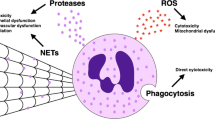Abstract
Objective
To examine the hypothesis that neutrophil chemotaxis to interleukin-8 (IL-8) is reduced in septic shock. Surface expression of neutrophil CXC chemokine receptors and the adhesion molecule CD11b were also examined and associations between disease severity, gas exchange and receptor expression were studied.
Design
Prospective cohort clinical study.
Setting
Intensive care unit in a tertiary referral teaching hospital.
Patients
Patients with septic shock (n=15) and healthy controls (n=8) were studied.
Measurements and results
Daily (for 5 consecutive days) flow cytometric measurements of chemokine and β integrin surface expression. “In vitro” neutrophil chemotaxis to IL-8 was also compared between patients with sepsis and healthy controls. CXCR2 expression significantly fell, CD11b expression increased and CXCR1 expression was unchanged throughout the study in the septic group compared with healthy controls. CD11b positively correlated with increasing APACHE II scores (p<0.0001) and worsening PaO2/FIO2 ratios (p<0.0001). CXCR2 expression negatively correlated with both APACHE II scores (p=0.016) and PaO2/FIO2 ratios (p=0.01). There was no correlation between CXCR1 expression and either APACHE II score or PaO2/FIO2 ratios. Chemotaxis to IL-8 was reduced in patients with sepsis compared with healthy volunteers.
Conclusions
Surface expression of the chemokine receptor CXCR2 and the β-integrin CD11b, but not CXCR1, were reduced on neutrophils isolated from patients with septic shock compared with healthy controls. Chemotaxis to IL-8 was also reduced in neutrophils from septic patients compared with healthy controls. The changes in receptor expression correlated with measures of disease severity.







Similar content being viewed by others
References
Wheeler AP, Bernard GR (1999) Treating patients with severe sepsis. N Engl J Med 340:207–214
Fujishima S, Aikawa N (1995) Neutrophil-mediated tissue injury and its modulation. Intensive Care Med 21:277–285
Luster AD (1998) Chemokines-chemotactic cytokines that mediate inflammation. N Engl J Med 338:436–445
Baggiolini M (1998) Chemokines and leukocyte traffic. Nature 392:565–568
Murphy PM (1997) Neutrophil receptors for interleukin-8 and related CXC chemokines. Semin Hematol 34:311–318
Bignold LP, Rogers SD, Siaw TM, Bahnisch J (1991) Inhibition of chemotaxis of neutrophil leukocytes to interleukin-8 by endotoxins of various bacteria. Infect Immun 59:4255–4258
Hartiala KT, Langlois L, Goldstein IM, Rosenbaum JT (1985) Endotoxin-induced selective dysfunction of rabbit polymorphonuclear leukocytes in response to endogenous chemotactic factors. Infect Immun 50:527–533
Territo MC, Golde DW (1976) Granulocyte function in experimental human endotoxemia. Blood 47:539–544
Frevert CW, Warner AE, Kobzik L (1994) Defective pulmonary recruitment of neutrophils in a rat model of endotoxemia. Am J Respir Cell Mol Biol 11:716–723
Solomkin JS, Bass RC, Bjornson HS, Tindal CJ, Babcock GF (1994) Alterations of neutrophil responses to tumor necrosis factor alpha and interleukin-8 following human endotoxemia. Infect Immun 62:943–947
Bjornson AB, Somers SD (1993) Down-regulation of chemotaxis of polymorphonuclear leukocytes following thermal injury involves two distinct mechanisms. J Infect Dis 168:120–127
Hasslen SR, Ahrenholz DH, Solem LD, Nelson RD (1992) Actin polymerization contributes to neutrophil chemotactic dysfunction following thermal injury. J Leukoc Biol 52:495–500
Jensen RH, Storgaard M, Vedelsdal R, Obel N (1995) Impaired neutrophil chemotaxis after cardiac surgery. Scand J Thorac Cardiovasc Surg 29:115–118
Tavares-Murta BM, Zaparoli M, Ferreira RB, Silva-Vergara ML, Oliveira CH, Murta EF, Ferreira SH, Cunha FQ (2002) Failure of neutrophil chemotactic function in septic patients. Crit Care Med 30:1056–1061
Cummings CJ, Martin TR, Frevert CW, Quan JM, Wong VA, Mongovin SM, Hagen TR, Steinberg KP, Goodman RB (1999) Expression and function of the chemokine receptors CXCR1 and CXCR2 in sepsis. J Immunol 162:2341–2346
Anonymous (1992) American College of Chest Physicians/Society of Critical Care Medicine Consensus Conference: definitions for sepsis and organ failure and guidelines for the use of innovative therapies in sepsis. Crit Care Med 20:864–874
Knaus WA, Draper EA, Wagner DP, Zimmerman JE (1985) APACHE II: a severity of disease classification system. Crit Care Med 13:818–829
Macey MG, McCathy DA (1993) Quantitation of adhesion molecules and other function-associated antigens on human peripheral blood leucocytes. Cytometry 14:898–908
Ali S, Palmer AC, Fritchley SJ, Maley Y, Kirby JA (2001) Multimerization of monocyte chemoattractant protein-1 is not required for glycosaminoglycan-dependent transendothelial chemotaxis. Biochem J 358:737–745
Vincent JL, Moreno R, Takala J, Willatts S, De Mendonc A, Bruining H, Reinhart CK, Suter PM, Thijs LG (1996) The SOFA (Sepsis-related Organ Failure Assessment) score to describe organ dysfunction/failure. On behalf of the Working Group on Sepsis-Related Problems of the European Society of Intensive Care Medicine. Intensive Care Med 22:707–710
Wagner JG, Roth RA (1999) Neutrophil migration during endotoxemia. J Leukoc Biol 66:10–24
Nelson S, Chidiac C, Bagby G, Summer WR (1990) Endotoxin-induced suppression of lung host defenses. J Med 21:85–103
Chishti AD, Dark JH, Kesteven P, Powell H, Snowden C, Shenton BK, Kirby JA, Baudouin SV (2001) Expression of chemokine receptors CXCR1 and CXCR2 during cardiopulmonary bypass. J Thorac Cardiovasc Surg 122:1162–1166
Zeilhofer HU, Schorr W (2000) Role of interleukin-8 in neutrophil signaling. Curr Opin Hematol 7:178–182
Bellingan GJ (2002) The pulmonary physician in critical care: the pathogenesis of ALI/ARDS. Thorax 57:540–546
Li F, Zhang X, Gordon JR (2002) CXCL8((3–73))K11R/G31P antagonizes ligand binding to the neutrophil CXCR1 and CXCR2 receptors and cellular responses to CXCL8/IL-8. Biochem Biophys Res Commun 293:939–944
Acknowledgement
This work was supported financially by the British Journal of Anaesthesia Project Grant.
Author information
Authors and Affiliations
Corresponding author
Rights and permissions
About this article
Cite this article
Chishti, A.D., Shenton, B.K., Kirby, J.A. et al. Neutrophil chemotaxis and receptor expression in clinical septic shock. Intensive Care Med 30, 605–611 (2004). https://doi.org/10.1007/s00134-004-2175-y
Received:
Accepted:
Published:
Issue Date:
DOI: https://doi.org/10.1007/s00134-004-2175-y




